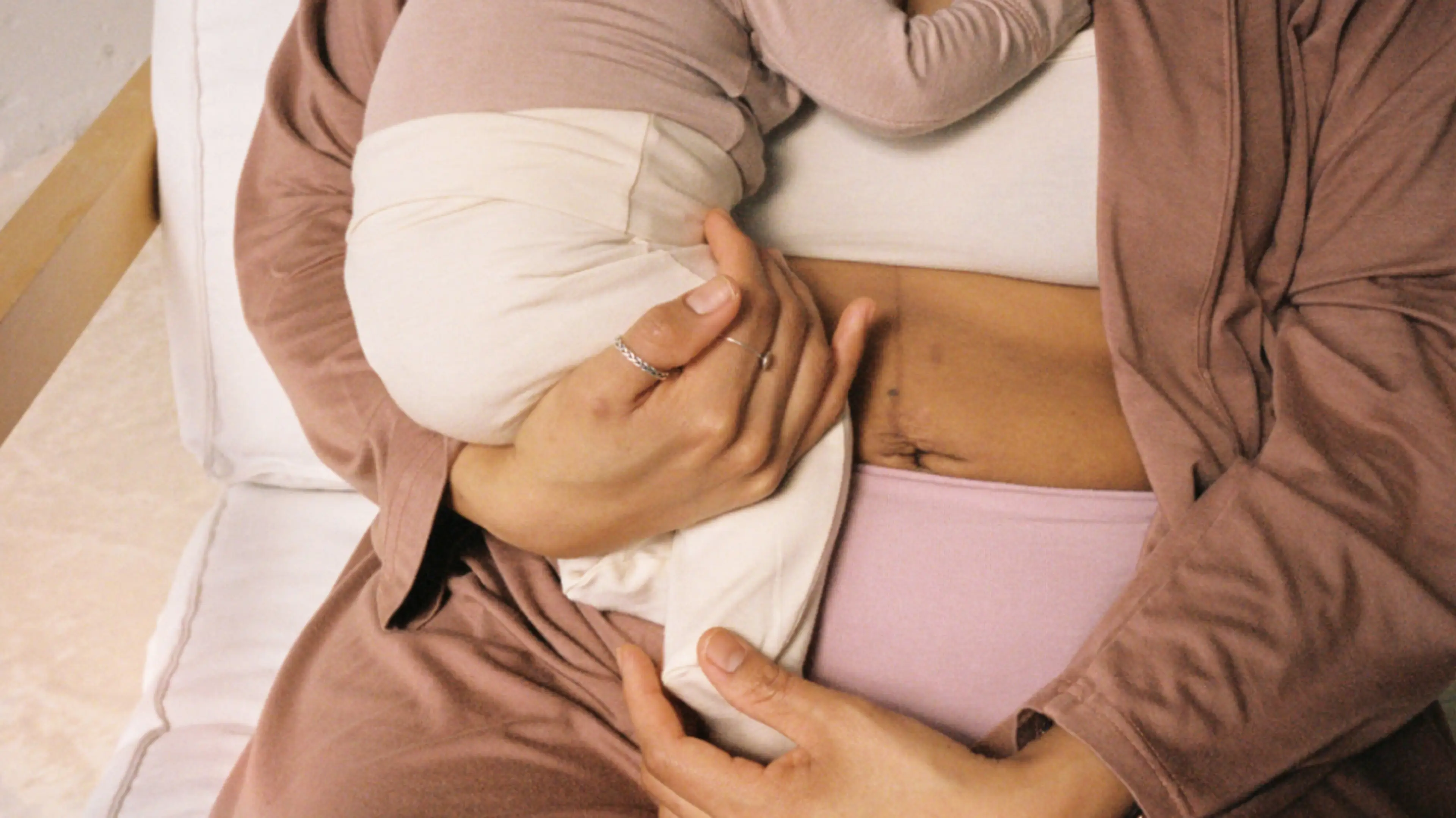TLDR: The postpartum period can be exhausting with a new baby, but once you’re up for it (and your doctor clears it), starting a workout routine can be beneficial. Light, low-impact exercise can help bring your energy back up, improve your mental health, and help your body recover from birth and pregnancy. Here are the reasons you should consider exercise during postpartum and the tips and exercises to get you started.
As you likely already know, exercising during pregnancy is great for your health. And getting active again after you give birth is just as important—and a great way to keep you feeling good physically and emotionally. While a postpartum workout can be beneficial for your recovery, sleep, and overall health, it’s important to ease into a routine that’s realistic for you as a new mom—and isn’t too hard on your postpartum body.
It may even be arguably more important if you’ve had a C-section, says Dr. Mae Hughes, a physical therapist who focuses on pregnancy, postpartum, and the pelvic floor1 . “An abdominal rehab program is standard of care after many abdominal surgeries, such as hernias, and C-sections are no different.” According to Hughes, early mobility and exercise helps to:
Reduce your risk of blood clot early after surgery
Reduce pain and discomfort
Improve your scar mobility
Increase your abdominal strength
Reduce low back pain
Improve pelvic floor function
Improve your mental health
Exercising can be a big part of your (very important) postpartum self-care routine. When you’re ready to start, here are some tips to make sure you get the most out of your postpartum workouts while also staying safe.
When Is It Safe to Start Working Out?
Your ob-gyn will most likely clear you for physical activity at your six weeks postpartum appointment. To avoid any potential complications, it’s advised to wait until this time to start any workout program2 , especially if you’re recovering from a C-section. “While early mobility is important after a C-section to improve blood flow, you don’t want to jump right back into your regular form of exercise,” Hughes says. “A C-section is a major abdominal surgery since they cut through several layers of tissue to deliver your baby, and these layers need to heal and develop tensile strength prior to applying pressure on them through exercise.”
Hughes says that if you had a C-section, you may need even more time than the standard six-week recommendation. “By about six weeks after delivery, your tissue only has about 50% of its original tensile strength, meaning it’s still weak and can’t tolerate your previous level of exercise.”
If you’re anxious to start moving your body again, going for short walks can benefit both vaginal and C-section recoveries. If you have any questions before your postpartum appointment, just give your doctor a call.
The Benefits of Postpartum Exercise
Whether you’re itching to get back to your pre-pregnancy workout routine or you’re just starting to get regular physical activity, there are many benefits of a postpartum workout routine.
Boosts energy
Let’s be real here—the postpartum period can be downright exhausting. Not only are you healing from pregnancy and childbirth, but you’re learning how to care for a brand new baby, maybe caring for other kids, managing your house, and possibly working. But if you’re feeling low on energy, you should actually consider some light physical activity.
This may sound counterintuitive when all you want to do is lie on the couch, but it’s been proven that light exercise can boost your low energy3 levels. Put your baby in the stroller and take a short walk around the block. The movement, fresh air, and nature can help charge your energy and give major muscle groups the TLC they need.
Core strengthening
Pregnancy is not kind to the core muscles. There’s less core strength, endurance, and stability in women up to six months postpartum4 . The core is an important group of muscles because they help stabilize your entire body—protecting your back from straining, supporting your pelvic floor, and reducing the chances of urinary incontinence.
Weight management
Postpartum workouts can help you lose weight in a gradual way—if that’s your goal. By slowly incorporating exercise, you may start to see positive effects on weight management. That goes double when paired with a healthy diet.
Mental health support
During the postpartum period, supporting your emotional and mental health is so important. Postpartum exercise can help improve many areas of your mental health, including boosting your mood and helping postpartum depression and anxiety.
What are the safest postpartum workouts?
Before you go all in on your new wellness routine, you’ll want to make sure you’re choosing the right exercises for you. Remember, your body has just been through a lot, and you won’t immediately be as strong as you were before giving birth.
Starting with exercises that don’t put too much strain on your healing body is important. Think of simple exercises that you can add on to later as you get your strength back.
Kegels
One exercise you can do while you’re snuggling your baby, driving in the car, or before you go to sleep are Kegel exercises. Kegels are pelvic floor contractions5 , and they help strengthen your pelvic floor muscles. These are the muscles that support the bladder, bowel, and uterus.
If you know how to do them, Kegels can be pretty easy. The muscles used in Kegels are the same ones you use when you’re trying to hold in your flow of urine. To do a Kegel, engage those muscles and hold that engagement for two or three seconds. Release. Do about ten reps of this movement at different points throughout the day.
Diaphragmatic breathing
Another exercise you can do early in postpartum is diaphragmatic breathing. This postpartum exercise routine can help gently strengthen your core muscles. Diaphragmatic breathing is as simple as taking a deep belly inhale. While this isn’t an exercise that will have extreme results, it will help to slowly strengthen your core while you aren't able to do more advanced exercises.
When you’re practicing diaphragmatic breathing, lie down on your back. Put one hand on your belly and one hand on your chest. Take a big breath in and pull the breath down to your abdomen. You should feel your hand on your belly rise. When you exhale, contract your abdominal muscles as it lowers. You can practice this breathing throughout the day and use it while sitting or standing once you get a feel for it.
Walking
If you’re looking for a low-impact, full-body postpartum workout, try adding more walking into your day. Starting slow can help your body ease back into more physical activity. Walking may also be beneficial for strengthening your bones and muscles, reducing calories, and boosting your mood. If you can only make it out to get the mail and back, that’s something! You’ll get your endurance back over time.
The best thing about walking is you don’t need any special equipment. Put on some comfy clothes and shoes, and do a quick lap around the neighborhood. If you can’t get away, let your baby join you in the stroller. Hughes adds, “Babywearing is my absolute favorite way to get in movement with your baby other than stroller walks!”
Yoga and Pilates
Workout programs like yoga and pilates are great for postpartum. Both of these workouts focus on the strengths of your own body. Yoga can help you regain your flexibility and balance. Pilates helps increase your energy6 and muscle strength. A basic cat-cow yoga pose with a starting position that keeps your spine neutral can help open and stretch your hips.
Remember to go at your own pace. There’s no need to rush—over time you’ll be surprised at the improvements you make.
Core work
Strengthening your core is always important, but especially during the postpartum period. Focus on exercises that engage the core muscles, but don’t put a lot of strain on the abs. This can be more harmful to your progress in the long run.
Ab workouts like leg extensions, pelvic tilts, and the pelvic bridge are ideal. Talking to a personal trainer or physical therapist can help you hone in on specific moves that’ll be beneficial for you, specifically in your postpartum workout plan.
What Exercises Should You Avoid Postpartum?
Some exercises are not safe during the postpartum recovery period. Certain core exercises like sit-ups, crunches, and planks may actually make a condition called diastasis recti worse by putting too much strain on your upper body. This condition is when your abdominal muscles pull apart during pregnancy—up to 60% of women may experience diastasis recti7 . Gentle core exercises can help correct this problem.
High-intensity aerobic activities and heavy weight lifting are also not safe for new moms. These exercises may cause unnecessary strain on your postpartum body and lead to pelvic organ prolapse or bleeding. If you have questions about whether your specific postpartum workout routine is appropriate for your situation, reach out to your ob-gyn.
Tips for Getting Started with Postpartum Workouts
If you’re ready to start a postpartum workout routine, use these tips to make the transition easier for you.
Take it slow
The number one tip is to take it slow. Finding a routine that works for you and your postpartum body can take a little while to figure out. Make sure you’re comfortable in the activities.
No matter what you choose—walking, pilates, or core exercises—start slowly and gradually increase the intensity, making sure to consult your healthcare provider with questions or concerns.
You may be able to work your way up to resistance training using a dumbbell, but you shouldn’t rush to get to this point.
Write down your goals
Before you start your postpartum workout routine, write down what your goals are. Are you hoping to increase your core strength, increase your energy, or lose weight? Whatever your goals are, write them down. It may help you stay more accountable to yourself.
Make a plan
After you write down your goals, make a plan. Are you going to go for a walk three days a week? Do you want to put on a yoga video during naptime? When you write down your plan, you’ll know what to expect that day. This may help you follow through with your exercise program.
Find a buddy
If you’re struggling to get motivated or just want some adult conversation, asking a friend if they want to start a workout program with you can be helpful. On those days when the couch and slippers look a lot cozier than your sneakers and the walk you have planned, it’s nice to have a buddy to help you stay motivated.










